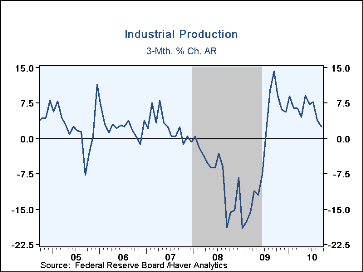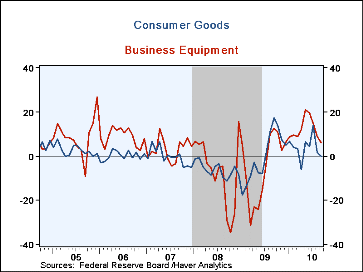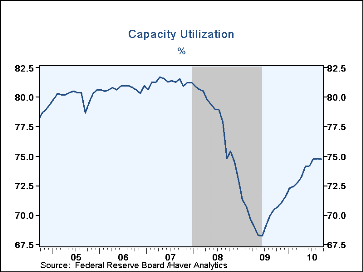 Global| Oct 18 2010
Global| Oct 18 2010U.S. Industrial Production is Unexpectedly Weak
by:Tom Moeller
|in:Economy in Brief
Summary
Momentum previously evident in industrial output growth has been lost. That's again the message from the report on production which fell last month. The decline compared to an expected 0.2% gain, and reversed an unrevised 0.2% August [...]
 Momentum previously evident in industrial output growth has been lost.
That's again the message from the report on production which fell last
month. The decline compared to an expected 0.2% gain, and reversed an
unrevised 0.2% August increase. Moreover, tepid performance during
the last two months stand in sharp contrast to increases between 0.5% and
1.5% extending back to July of last year. Lost momentum is clear in
output's three-month growth rate. It's fallen to 2.6% from its peak
of 14.3% one year ago. Some of the slowdown was to be expected
following the usual spurt in output following a recession. The difference
between the recent slowdown and others, however, is that initial gains
coming out of recession were less substantial than others in terms of
magnitude and duration. Following the 1981-82 recession, for example,
industrial production grew at a double digit rate for roughly one year
before decelerating.
Momentum previously evident in industrial output growth has been lost.
That's again the message from the report on production which fell last
month. The decline compared to an expected 0.2% gain, and reversed an
unrevised 0.2% August increase. Moreover, tepid performance during
the last two months stand in sharp contrast to increases between 0.5% and
1.5% extending back to July of last year. Lost momentum is clear in
output's three-month growth rate. It's fallen to 2.6% from its peak
of 14.3% one year ago. Some of the slowdown was to be expected
following the usual spurt in output following a recession. The difference
between the recent slowdown and others, however, is that initial gains
coming out of recession were less substantial than others in terms of
magnitude and duration. Following the 1981-82 recession, for example,
industrial production grew at a double digit rate for roughly one year
before decelerating.
Factory sector output alone slipped 0.1% during September after an unrevised 0.1% August uptick. The consumer goods sector was the weakest. Here, output fell 0.4% after a 0.5% August decline. Output's decline reversed all of a 1.0% July spurt and the zero-percent three-month growth rate compares to 17.4% one-year ago. Weakness was led last month by lower durable consumer goods production. It fell 1.0% (+4.3% y/y) which owed to a 1.9% drop (-0.1% y/y) in appliance, furniture and carpeting output. Auto output also fell 0.9% (+5.1% y/y) but output of computers, video & audio equipment rose 0.6% (-3.0% y/y). Nondurable goods output slipped 0.2% (+2.8% y/y).
Capacity utilization overall ticked lower to 74.7% but remained well above last year's low of 68.2%. A 74.8% September rate had been expected. The factory sector utilization rate, alone, slipped to 72.2%. The increase here is from the low of 65.4% during the recession. But the figures continue to paint a picture of abundant unused productive capacity. The latest rates compare to roughly 80% just before the recession and a fifty year average also of 80%. Industrial production and capacity data are included in Haver's USECON database, with additional detail in the IP database.
| Industrial Production (SA, % Change) | September | August | July | Year Ago | 2009 | 2008 | 2007 |
|---|---|---|---|---|---|---|---|
| Total Output | -0.2 | 0.2 | 0.6 | 5.4 | -9.3 | -3.3 | 2.7 |
| Manufacturing | -0.1 | 0.1 | 0.7 | 5.5 | -11.1 | -4.5 | 2.9 |
| Consumer Goods | -0.4 | -0.5 | 1.0 | 3.2 | -5.8 | -4.2 | 0.9 |
| Business Equipment | 0.1 | 0.3 | 1.1 | 10.1 | -12.2 | -1.5 | 4.5 |
| Construction Supplies | -0.8 | 1.0 | -0.5 | 5.3 | -16.7 | -9.5 | -1.2 |
| Materials | 0.0 | 0.5 | 0.5 | 6.4 | -9.7 | -2.7 | 3.7 |
| Utilities | -1.9 | -1.4 | 0.9 | 2.7 | -2.6 | -0.1 | 3.4 |
| Capacity Utilization (%) | 74.7 | 74.8 | 74.7 | 70.5 | 70.0 | 77.9 | 81.3 |
| Manufacturing | 72.2 | 72.3 | 72.2 | 68.1 | 67.2 | 75.0 | 79.6 |
Tom Moeller
AuthorMore in Author Profile »Prior to joining Haver Analytics in 2000, Mr. Moeller worked as the Economist at Chancellor Capital Management from 1985 to 1999. There, he developed comprehensive economic forecasts and interpreted economic data for equity and fixed income portfolio managers. Also at Chancellor, Mr. Moeller worked as an equity analyst and was responsible for researching and rating companies in the economically sensitive automobile and housing industries for investment in Chancellor’s equity portfolio. Prior to joining Chancellor, Mr. Moeller was an Economist at Citibank from 1979 to 1984. He also analyzed pricing behavior in the metals industry for the Council on Wage and Price Stability in Washington, D.C. In 1999, Mr. Moeller received the award for most accurate forecast from the Forecasters' Club of New York. From 1990 to 1992 he was President of the New York Association for Business Economists. Mr. Moeller earned an M.B.A. in Finance from Fordham University, where he graduated in 1987. He holds a Bachelor of Arts in Economics from George Washington University.








